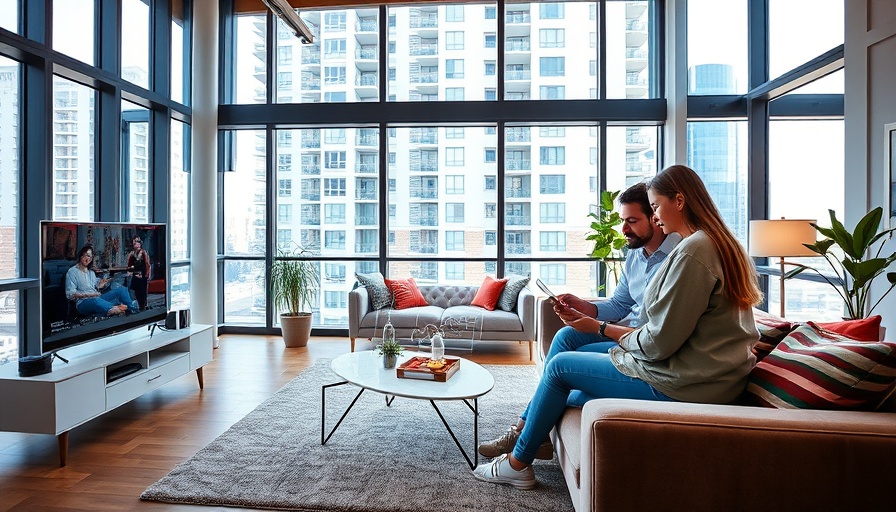
How Technology is Shaping Modern Interior Design
Technology is more than just a tool; it has become an integral part of the modern interior design process, enabling innovative solutions that cater to the health, wellness, and aesthetic needs of homeowners. In Maryland, where healthy living is favored, the synergy of design and technology is particularly significant. As we explore these innovations, we'll see how homeowners can create personalized and energy-efficient environments.
Smart Home Technology: Elevating Comfort and Efficiency
Smart home technology plays a pivotal role in today’s interior design. These devices allow homeowners to control various aspects of their living spaces seamlessly, enhancing comfort and energy efficiency. For instance, smart thermostats learn the habits of residents, making automatic adjustments to optimize climate control and reduce energy costs. With features like voice commands and smartphone applications, it's easier than ever to manage home settings from anywhere.
Moreover, smart lighting solutions, which can be controlled remotely or set to adjust automatically based on natural light, are becoming increasingly popular. They not only provide convenience but also contribute to sustainable living—a concern that resonates strongly with the environmentally conscious audiences in Maryland.
The Immersive Experience of Virtual Reality (VR) and Augmented Reality (AR)
The use of Virtual Reality (VR) and Augmented Reality (AR) has transformed how interior designers can present their ideas. These technologies create immersive experiences for clients, allowing them to visualize potential designs before any physical work begins. This means homeowners can see how furniture fits, experiment with colors, and understand spatial dynamics—all from the comfort of their couch.
In Maryland, where community and family are essential, these visual tools can help design spaces that not only look great but function well for everyday life. Homeowners can make informed decisions, reducing the potential for costly design mistakes, while also fostering a sense of pride in their personalized spaces.
AI-Driven Solutions: Personalized Design at Your Fingertips
Artificial Intelligence (AI) is also making waves in interior design. By analyzing user preferences and space data, AI applications can recommend optimal layouts and materials that align with both the client’s lifestyle and sustainability goals. This data-driven approach means more personalized designs tailored to meet the individual needs of homeowners.
In Maryland, where historical and modern aesthetics blend, AI tools can also help preserve the unique charm of traditional homes while integrating contemporary comforts.
The Impact of Digital Media on Interior Design
As the digital landscape evolves, so does the way designers communicate and showcase their work. Social media platforms allow for broader visibility, fostering connections between designers and potential clients. High-quality rendering software enables polished presentations, making it easier to share design visions and attract clients.
For Maryland residents, digital platforms can offer insights into local design trends, bridging the gap between aesthetic appeal and the flexibility that contemporary technology affords.
Benefits of Integrating Smart Technology in Your Home
Integrating smart technology goes beyond mere aesthetics—it enhances the overall living experience. With features that adapt to personal preferences and improve energy efficiency, homeowners can create a more comfortable environment that supports healthy living. This is particularly relevant for those in Maryland, where wellness is a key focus.
Additionally, with systems that merge functionality with design, homes can reflect not just beauty but also the values of sustainability and modern convenience, ultimately shaping a healthier and more engaged lifestyle.
Challenges and Considerations for Smart Home Integration
While smart technologies offer numerous benefits, integrating them into interior design can present challenges. Interior designers must balance the aesthetic implications of technology with the practical needs of their clients. Misunderstandings regarding client preferences can lead to mismatches in design vision versus execution.
Moreover, the continuous evolution of technology poses a risk when planning future-proof designs. Designers need to stay informed about emerging trends and tech advancements to ensure that their design solutions remain relevant. By fostering open discussions with clients about their technological capabilities and style aspirations, designers can navigate these challenges more effectively.
A Vision for the Future: The Role of Technology in Interior Design
As Maryland embraces technological innovation in home design, homeowners can take advantage of the latest trends to create spaces that are not only beautiful but are also functional and responsive to changing lifestyles. From smart home automation to advanced visualization tools, the future of interior design is bright, promising environments that nurture well-being and creativity.
In conclusion, by integrating these technologies, designers can enhance the living experience for Maryland homeowners, ensuring that their spaces are as unique as they are. As new innovations continue to surface, embracing technology will remain key to shaping the future of interior design.
Call to Action: Are you ready to transform your living space? Explore the latest in smart home technology and discover how you can create an innovative home that reflects your lifestyle. Join a local workshop or consult with a Maryland interior designer who specializes in technology integration for personalized insights!
 Add Row
Add Row 
 Add Element
Add Element 


Write A Comment